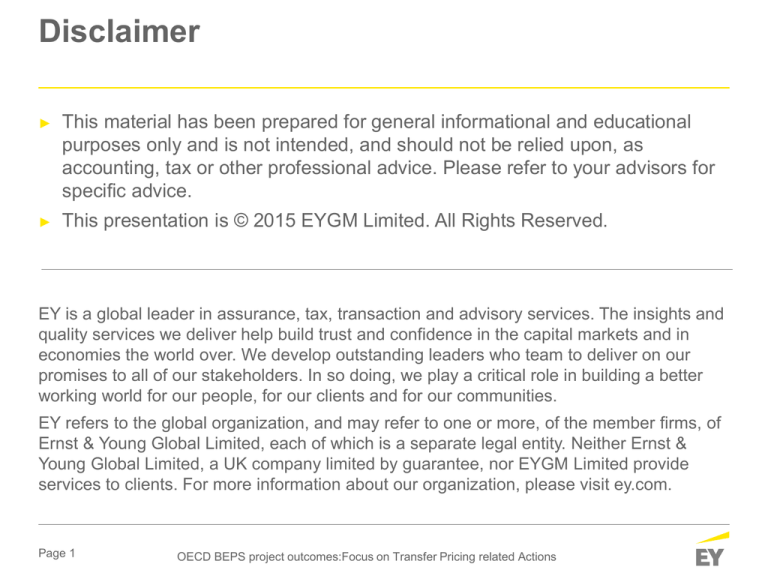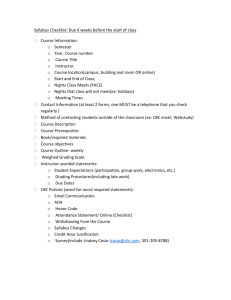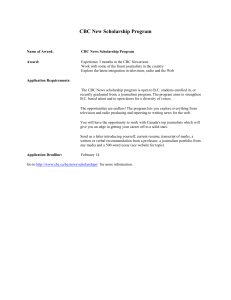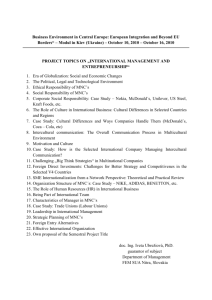
Disclaimer
►
This material has been prepared for general informational and educational
purposes only and is not intended, and should not be relied upon, as
accounting, tax or other professional advice. Please refer to your advisors for
specific advice.
►
This presentation is © 2015 EYGM Limited. All Rights Reserved.
EY is a global leader in assurance, tax, transaction and advisory services. The insights and
quality services we deliver help build trust and confidence in the capital markets and in
economies the world over. We develop outstanding leaders who team to deliver on our
promises to all of our stakeholders. In so doing, we play a critical role in building a better
working world for our people, for our clients and for our communities.
EY refers to the global organization, and may refer to one or more, of the member firms, of
Ernst & Young Global Limited, each of which is a separate legal entity. Neither Ernst &
Young Global Limited, a UK company limited by guarantee, nor EYGM Limited provide
services to clients. For more information about our organization, please visit ey.com.
Page 1
OECD BEPS project outcomes:Focus on Transfer Pricing related Actions
OECD BEPS project
outcomes: Focus on
Transfer Pricing related
Actions
TEI Carolinas Chapter
12 November 2015
Karen Kirwan
EY International Tax
Services—Transfer Pricing
Washington, DC
Page 3
OECD BEPS project outcomes:Focus on Transfer Pricing related Actions
Final BEPS reports
►
On 5 October 2015, the OECD issued its final reports on the 15 focus areas identified in its Action
Plan on Base Erosion and Profit Shifting (BEPS). These were discussed and endorsed at the G20
Finance Ministers' meeting on 8 October 2015.
►
The recommendations range from new minimum standards to reinforced international standards to
common approaches and best practices.
Minimum standards
►
►
►
►
Action 5 – Harmful tax
practices
Action 6 – Treaty abuse
Action 13 – Country-bycountry reporting
Action 14 – Dispute
resolution
Reinforced standards
►
OECD Transfer Pricing
Guidelines
►
►
►
OECD Model Tax Convention
►
►
►
►
►
Actions 8-10 (transfer pricing)
Action 13 (transfer pricing
documentation)
Action 2 (hybrid mismatch
arrangements)
Action 6 (treaty abuse)
Action 7 (permanent
establishment status)
Action 14 (dispute resolution)
Common approaches
and best practices
►
►
►
►
Action 2 – Hybrid mismatch
arrangements
Action 3 – Controlled
foreign company (CFC)
rules
Action 4 – Interest
deductions and other
financial payments
Action 12 – Mandatory
disclosure rules
The output also includes analytical reports on Action 1 (digital economy), Action 11 (economic
analysis) and Action 15 (multilateral instrument)
Page 4
Impact of BEPS final reports
►
The final reports on the 15 Actions differ in timing of impact and further steps are needed.
►
Some measures may have (almost) immediate effect in a number of countries; others require treaty
based action or legislative action by countries. The OECD also has announced plans for additional
work on some Actions.
Immediate impact
►
►
►
►
Action 8 – Transfer pricing
for intangibles
Action 9 – Transfer pricing
for risks and capital
Action 10 – Transfer
pricing for other high-risk
transactions
Action 13 – Transfer
pricing documentation and
country-by- country
reporting
Treaty-based action
►
►
►
►
►
►
►
►
►
Action 2 – Hybrid mismatch
arrangements
Action 3 – CFC rules
Action 4 – Interest
deductions and other
financial payments
Action 5 – Harmful tax
practices
Further development
►
►
Page 5
Action 2– Hybrid mismatch
arrangements
Action 6 – Treaty abuse
Action 7 – Permanent
establishment status
Action 14 – Dispute resolution
Action 15 - Multilateral
instrument
Legislative action
Follow on work on several Actions
Framework for monitoring country implementation and
involvement of additional countries
Action 13: Country-by-Country reporting (CbC)
Who, when, where, how and what?
►
►
►
Multinational groups with
consolidated revenue of € 750
Country-bymillion or more
Country report
Fiscal years beginning on or
High level information about
MNC’s jurisdictional
after 1 January 2016, with first
allocation of revenue, profit,
Country-by-Country (CbC)
taxes, assets and
reports to be filed by 31
employees to be shared with
December 2017
all tax authorities where
MNC has operations
Filing with tax authority in
parent country, to be shared
with tax authorities in
countries where group has
Transparency
entities or branches
► Secondary reporting either
readiness
directly by each local entity
or for group
by ‘surrogate parent’ entity
Page 6
Master file
High level information
about MNC’s business,
transfer pricing policies and
agreements with tax
authorities in single
document available to all
tax authorities where MNC
has operations
Local file
Detailed information about
MNC’s local business,
including related party
payments and receipts for
products, services,
royalties, interest, etc.
CbC reporting template
Table 1 and Table 2
Table 1:
Revenues
Tax
jurisdiction
Unrelated
party
Related
party
Total
Profit (loss)
before
income tax
Cash Tax
Paid (CIT
and WHT)
Current year Stated
tax accrual capital
Accumu
lated
earnings
Tangible
assets other
than cash
and cash
equivalents
Number of
employees
1.
2.
3.
4.
5.
Table 2:
1.
2.
3.
1.
2.
Page 7
Other
Dormant
Holding shares
or other equity
instruments
Insurance
Regulated
financial
services
Internal group
finance
Provision of
services to
unrelated
parties
Admin., Mgmt
or support
services
Sales,
marketing or
distri.
Mfg or
production
Purchasing or
procurement
Holding or
managing IP
Tax
jurisdiction
Main business activity(ies)
R&D
Constituent
entities
resident in
the tax
jurisdiction
Tax jurisdiction
of organization
or
incorporation if
different from
tax jurisdiction
of residence
CbC reporting
Implementation status
Non compliance is
a criminal offense
in the Netherlands
Status
Already implemented
Implementation in progress
Mandatory for
large UK parented
groups only
China: Filing due
with tax return on
31 May
Page 8
Spain’s group definition based on
control
Does not include surrogate parent
concept
Equity rather than stated capital and
accumulated earnings
CbC reporting
Implementation specifics
OECD
United
Kingdom
Spain
Poland
Status
Implementation
packages released in
February and June
2015 with model
legislation and model
competent authority
agreements
Draft regulations Adopted
published
implementing
regulations on
11 July 2015
Who
Ultimate Parents of
group with revenue
of EUR 750 million
or greater
Threshold of
£586 million
(approximately
EUR 790
million)
When
For fiscal years starting
in 2016, with filing
within 12 months from
fiscal year end
Secondary
filing rule
1. Local filing or
2. Filing by named
“Surrogate Parent”
entity
Voluntary local
filing
Local filing
Penalties
Left to countries
Specific penalty
for non
compliance
General penalty Transfer pricing
for non
documentation
compliance
penalties
Denmark
China
Implementing Bill
produced and
under review
Draft legislation
published
Draft legislation published
Threshold of AUD
1 billion
(approximately
EUR 670 million)
Threshold of
Threshold of RMB 5 billion
DKK 5.6 billion
(approximately EUR 705
(approximately
million)
EUR 750 million)
Netherlands
Draft legislation
published
Mexico
Draft legislation
published
Threshold of 12
billion pesos
(approximately
EUR 650 million)
To be filed together with
the annual tax return (due
31 May). Possible to apply
for an extension.
Enforcement period not
specified.
Consistent with OECD recommendations
Page 9
Draft regulations
published
Australia
Not required
Local filing
General penalty
for non
compliance
Local filing
General penalty
for non
compliance
No information yet
Criminal penalty for
non compliance
General penalty for
non compliance
Who is the reporting entity?
Group: Collection of two or more enterprises related through ownership or control such that
it is required to prepare consolidated financial statements (or would be so required
if publicly traded)
Ultimate Parent
►
►
Top entity
No other entity owns a
controlling interest
Any local entity
►
►
►
►
►
►
Files CbC report with tax
authority where it is resident
Tax authority will share with other
countries under information
exchange relationships
PRIMARY
REPORTING
Page 10
►
Surrogate Parent
If country of Ultimate Parent
does not require CbC reporting
for the Group, or
Local country is not receiving
CbC report from Ultimate Parent
jurisdiction
Unless the Group appoints
Surrogate Parent, and
Local country rules allow for
Surrogate Parent
►
Files CbC report with tax
authority in each such local
country under country’s rules
►
►
►
If country of Surrogate Parent
requires CbC reporting and
local country has arrangement
in place to receive such
information from country of
Surrogate Parent, and
Country of Surrogate Parent
and local country both have
been informed
Files CbC report with tax authority
where it is resident
Tax authority will share with other
countries under information
exchange relationships
SECONDARY REPORTING
Specific secondary reporting mechanism
UK subsidiaries of non-UK MNCs
are not required to file a CbC
report. They may do so voluntarily
for instance to serve as a
Surrogate Parent.
Spain and China: No
Surrogate Parent provision
in the legislation; only
secondary filing
mechanism is local filing
Follows OECD
Page 11
Local reporting entity filing
No filing required
No details yet
Voluntary local filing
Priority focus
CbC reporting methodology
Phase 1a:
CbC reporting
assessment tool
► To create an overall picture of the information to be
submitted to the tax authorities
► To anticipate the questions/issues that could be raised
► To consider remediation needs
Sustainable reporting
► Develop a high level overview of IT landscape specifically
for CbC reporting
Phase 1b:
Current state readiness
► Identify challenges for the enterprise in the ‘real world’ for
CbC reporting
► Identify early any system/data gaps
► Build overall CbC reporting data inventory
Phase 2:
Data inventory
► Identify any gaps in controls and processes for future state
CbC reporting
► Identify solutions to address data and process challenges
Phase 3:
Repository configuration
► Implement data/system solution within the current IT
infrastructure
► Configure CbC reporting data repository
► Deliver CbC report, master and local file reports
Page 12
Phase 1a: CbC reporting assessment tool
Sample reports
Profit per employee vs.
Effective Tax Rate (ETR)
►
Visualization of profit per
employee vs. ETR by
tax jurisdiction
►
Ability to filter by
business activity and
division
Page 13
Phase 1a: CbC reporting assessment tool
Sample reports
Related party revenue
►
Visualization of
related party
revenue vs. total
revenue and profits
vs. total revenue
Page 14
Related party
revenue/Total revenue
Profit/Total revenue
Phase 1b: Current state readiness
High level data and technology readiness assessment
►
Data readiness assessment
►
►
►
►
Review current IT landscape and identify potential data sources
Identify what data is present in the organization’s data warehouse
Benchmark the environment’s complexity to determine the most
appropriate solution for gathering, transforming and reporting on
the CbC reporting data
Tools and technology assessment
►
►
►
Page 15
Understand existing technology environment for extracting and
gathering source data, analyzing and transforming data and
consolidating and reporting for similar purposes
Compare new requirements to current technology
Analyze and recommend alternatives or incremental approaches
for technology and reporting tools and processes
Phase 2: Data inventory
Mapping data points and requirements gathering
►
Data inventory
►
►
►
►
►
Document and map data requirements to existing sources
Determine transformation necessary to reach fit-for-purpose
validated data
Establish the processes and resource requirement to
address data readiness gap
Define taxonomy to store unstructured data
Requirements gathering
►
Page 16
Gather and document requirements with respect to data
analysis capabilities, reporting capabilities and audit trail
Phase 3: Repository configuration
CbC reporting data collection
One challenge that many MNCs are facing is how to collect and collate the
information required for the reports from their various systems across the globe.
Some MNCs will be able to source data centrally from consolidating systems,
while others may need to use local data sources.
Data
►
(Sub) consolidated trial
balances and cash flow
statements
►
Single or multiple ERP
systems
►
Supplemental data from
other systems or
manual input
►
Exchange rate
information
Page 17
Processing
Outputs
►
Categorization
►
Upload or extraction
►
Risk analysis
►
Mapping
►
Visualization
►
Cleansing
►
Scenarios
►
Adjusting
►
Reporting
►
Scenario analysis
►
Real-time monitoring
►
Ratio calculations
►
Customized reports
►
Assessment:
Action 13: Master file
Who, when, where, how and what?
►
►
►
►
►
All MNCs operating in
countries that require
master file above a
certain threshold
Not all countries require
master file
Some countries have
(different) threshold
amounts
Possibly for financial
years starting on or
after 2016
Filed with local tax
authorities through
normal transfer pricing
documentation
procedures
Page 18
Country-byCountry report
High level information about
MNC’s jurisdictional
allocation of revenue, profit,
taxes, assets and
employees to be shared with
all tax authorities where
MNC has operations
Master file
High level information
about MNC’s business,
transfer pricing policies and
agreements with tax
authorities in single
document available to all
tax authorities where MNC
has operations
Local file
Transparency
readiness
Detailed information about
MNC’s local business,
including related party
payments and receipts for
products, services,
royalties, interest, etc.
Master file
Information required
Organization
structure
Business description
Intangibles
Intercompany
financial activities
Financial and tax
positions
Structure chart:
Important drivers of business
profit
Overall strategy
description
Financing
arrangements for the
group
Annual consolidated
financial statements
► Legal
Supply chain of:
► 5 largest products/services
by turnover
► Products/services
generating more than 5%
of turnover
List of important
intangibles and
legal owners
Identification of
financing entities
List and description
of existing unilateral
Advance Pricing
Agreements (APAs)
and other tax rulings
Main geographic markets of
above products
List of important
intangible
agreements
Details of financial
transfer pricing
policies
List and brief description of
important service
arrangements
R&D and
intangible transfer
pricing policies
Functional analysis of
principal contributions to value
creation by individual entities
Details of
important
transfers
ownership
► Geographic
location
Business restructuring/
acquisitions/ divestitures
during fiscal year
Page 19
Master file
Questions
►
►
How different is it from current master file practice?
How many master files?
►
Jurisdictional considerations
►
►
►
►
►
►
►
Organizational considerations
What is meant by operating entity?
►
►
Different association thresholds
Different revenue thresholds
Legal/constituent/dormant?
JV/ minority interests?
Consistency with CbC reporting?
Materiality?
Language?
Page 20
Master file
Flexible and scalable approach?
The organizational set-up is often diverse and provides some complexity for the master file
1
Division A
2
Business
unit 1
3
4
Sub-unit
A
Micro
division 1
Micro
division 2
Division B
Business
unit 2
Sub-unit
B
Sub-unit C
Micro
division 3
Micro
division 4
Business
unit 3
Sub-unit D
Micro
division 5
Micro
division 6
Micro
division 7
Page 21
Sub-unit E
Micro
division 8
Micro
division 9
1
Division/group level
2
Business unit level
3
Sub-unit level
4
Micro division level
Master file
What level?
Compliance with the Action 13 Master file requirements
# of Master files
MNC X
►Master file can be prepared at a
“company level”
1.
Divisi
on
level
►Master file can be prepared at a
“divisional level”
2.
Business unit level
Page 22
►Master file can be prepared at a
“business unit level”
3.
Sub-unit level
►Master file can be prepared at a
“sub-unit level”
4.
Micro division level
►Master file can be prepared at a
“micro division level”
1
2
3
5
9
Action 13: Local file
Who, when, where, how and what?
►
►
►
►
►
►
All MNCs operating in
jurisdictions that require
local file (above local
country threshold)
Not all countries require
local file
Some have (different)
threshold amounts
Possibly for financial
years starting on or
after 2016
Filed with local tax
authorities
Through normal
transfer pricing
documentation
procedures
Page 23
Country-byCountry report
High level information about
MNC’s jurisdictional
allocation of revenue, profit,
taxes, assets and
employees to be shared with
all tax authorities where
MNC has operations
Master file
High level information
about MNC’s business,
transfer pricing policies and
agreements with tax
authorities in single
document available to all
tax authorities where MNC
has operations
Local file
Transparency
readiness
Detailed information about
MNC’s local business,
including related party
payments and receipts for
products, services,
royalties, interest, etc.
Local file
Information required
Local entity
► Management
structure
► Local
organization chart
► Details on
individuals to
whom local
management
reports
Controlled transactions
► Description of material controlled
►
►
►
►
transactions and context in which they
take place.
Identification of associated enterprises
party to controlled transactions and
relationship
Functional analysis
Transfer pricing methods used
Comparables and details of methodology
Financial Information
Local entity financial
statements
Description of
business and
business strategy
pursued
Amounts of intra-group payments and
receipts for controlled transactions (i.e.
products, services, royalties, interest etc.)
Reconciliation to show how
financial data used in applying
the transfer pricing method ties
to the financial statements
Details of business
restructurings and/or
intangible transfers
Unilateral and bilateral/multilateral APAs and
other tax rulings related to the controlled
transactions
Summary of relevant financial
data for comparables and
sources from which data was
obtained
Key competitors
R&D and intangible transfer
pricing policies
Details of important transfers
Page 24
Local file
Questions
►
►
►
►
►
►
►
Materiality thresholds?
Price setting or outcome testing?
Reconciliation with local financial reporting
What is meant by payment?
Are database searches updated on a regular basis?
What rulings and APAs are to be included?
How is the documentation process organized?
Page 25
Master/Local File
Implementation status
Poland: master file mandatory for
entities larger than 20 million
euros, local file more than 10
million
Status
Already implemented
Implementation in progress
Spain:
mandatory for
groups larger
than 45 million
Singapore and Greece already implemented documentation
requirements similar to Action 13 master file and local file
Page 26
Action 13: Transparency readiness
►
Companies need to be
ready for increased
transparency
►
Actively monitor the
changing landscape
►
Assess readiness for
new reporting
►
Communicate with
internal and external
stakeholders
►
Consider additional
explanatory reporting
►
Consider broader
proactive engagement
with tax authorities
Page 27
Country-byCountry report
High level information about
MNC’s jurisdictional
allocation of revenue, profit,
taxes, assets and
employees to be shared with
all tax authorities where
MNC has operations
Master file
High level information
about MNC’s business,
transfer pricing policies and
agreements with tax
authorities in single
document available to all
tax authorities where MNC
has operations
Local file
Transparency
readiness
Detailed information about
MNC’s local business,
including related party
payments and receipts for
products, services,
royalties, interest, etc.
Action 13: Looking ahead
►
Consistency
►
►
►
►
►
Management approach
►
►
►
Master file; Local file; CbC report
Reconciliation with tax returns
Reconciliation with financial statements
Reconciliation with transfer pricing policy
Central or local
Involvement of other stakeholders
Preparation for questions and controversy
Page 28
Action 8-10
Intangibles/ Risk & Capital/ High Risk Transactions
What happened
►
New versions of:
►
►
►
►
►
►
►
►
Commodity transactions (additions to Chapter II of the
OECD TP Guidelines)
Low-value adding intragroup services (revisions to
chapter VII of the OECD TP Guidelines)
Amended guidance on:
►
Identification of the actual transaction undertaken
Control of a risk
When the actual transaction undertaken may be
disregarded for transfer pricing purposes
Unchanged guidance (2014 Report on Intangibles)
on comparability factors including:
►
►
Chapter VI of the OECD TP guidelines addressing
intangibles, including new guidance on the return to
funding activities and on hard-to-value intangibles
Chapter VIII of the OECD TP guidelines, covering cost
contribution arrangements
New guidance on:
►
Questions to ask
Location savings, assembled workforce, and MNE
group synergies (additions to chapter I of the OECD TP
Guidelines)
Page 29
What is the relevance of OECD Transfer
Pricing Guidelines in the countries where your
company operates?
►
►
►
►
No relevance
Soft law
Reference to OECD guidelines
When and how do revisions to these
guidelines become effective in these
countries?
Overview of countries with Actions 8-10
activity
Page 30
Resources
BEPS online: ey.com BEPS site
Overall BEPS assessment
framework
Action 13 material
► Action 13 overview
► Action 13 implementation survey
► CbC reporting readiness
Tax Alerts online: ey.com/taxalerts
Twitter:
@EY_Tax
Mobile devices:
ey.com/TaxGuidesApp
ey.com/EYInsights
Page 31
www.ey.com/tax






